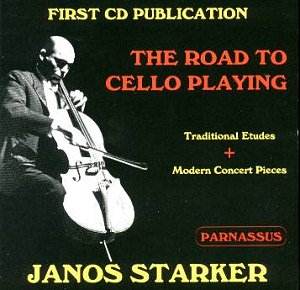The Road to Cello Playing is a tough one. In his notes
reprinted from the original 1967 LP (and revised thirty years later)
Janos Starker states his twin aims Ė the aesthetic pleasure of simply
hearing a cellist play works written for the practice room and also
the pedagogic advantage for a student as to how these Etudes actually
sound. The choice of work is Starkerís alone, and they are ones that
brought back memories of his own youthful study, good or bad, though
as he admits he has slightly exaggerated the expressive content to emphasise
the aesthetic component of his purpose. So some tempi and dynamics are
less strict than they would otherwise be Ė the musical melos is promoted
in the interests of auditory interest even if, as he honestly admits,
this is necessarily "inconsistent with regard to the training purposes
of the work."
Some of that expressive potential can best be felt
in Dotzauerís Etude in G and in Duportís crippling Etude No. 7 in G
minor we can hear Starker surmounting a myriad technical difficulties
with stunning panache. Intonation, voicings, bowing, articulation, stretching,
maintenance of melody lines, these are just the start of the tremendous
pedagogic value enshrined in these "daily dozen" Ė even if
Starker is honest enough to admit that some may be disillusioned when
hearing him playing them (and pragmatic enough to add that if they are
disillusioned they shouldnít join the profession). Itís especially good
to hear the Piatti and Popper Etudes. The nobility he imparts to the
formerís Op. 25/9 (in D) is astonishing and the aerated drive through
the latterís selection from Op. 73 jaw-dropping.
To conclude the disc we have three solo works; the
Sonata for solo cello by Hindemith, Cassadoís splendid and now popular
Suite and Bernhard Heidenís Variations. All are undated broadcast performances
and come from Starkerís own collection of recordings. The leonine drive
of his Hindemith is matched by the incipient drama of its opening movement
Lebhaft, sehr markiet. He catches the humour Ė thematic and registral
- of the Massig schnell second movement of this five-movement
work with regal exactitude. The harmonics of the Cassado are surmounted
with great skill, the fantastical sonorities buttressed with secure
technical flourish. His Sardana is idiomatic and the Intermezzo e
danza finale with its arco and pizzicato games, the dashing Spanishry
of its profile, its dynamic gradations and drive is marshalled by Starker
into a thing complete in itself.
Whilst interest in this disc might be limited to its
pedagogic function no Starker disc is without interest, especially one
to which these solo works have been added.
Jonathan Woolf

